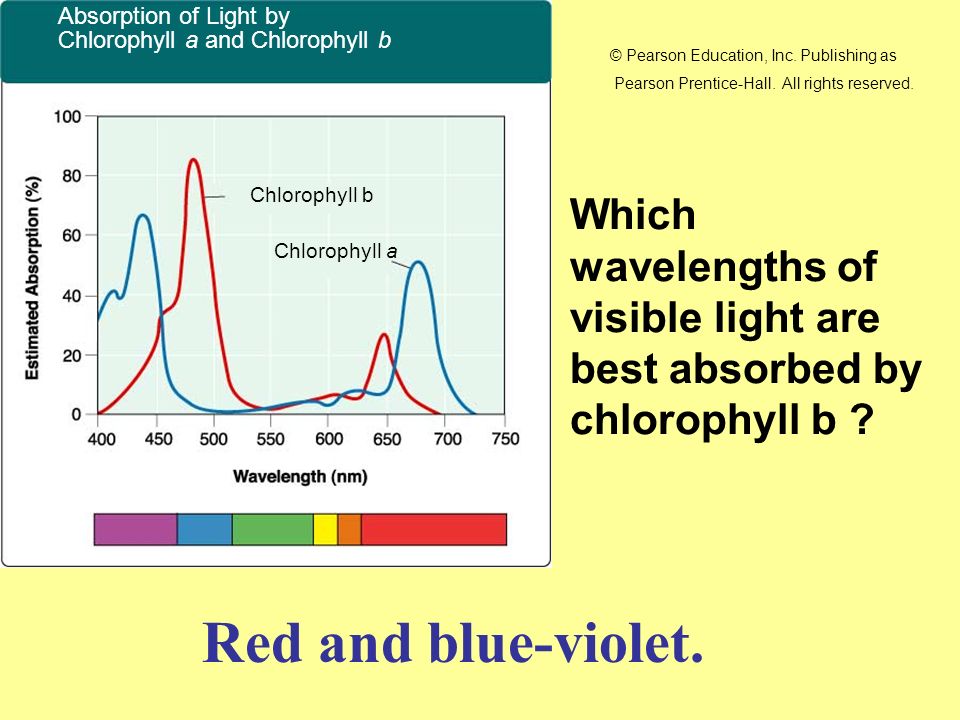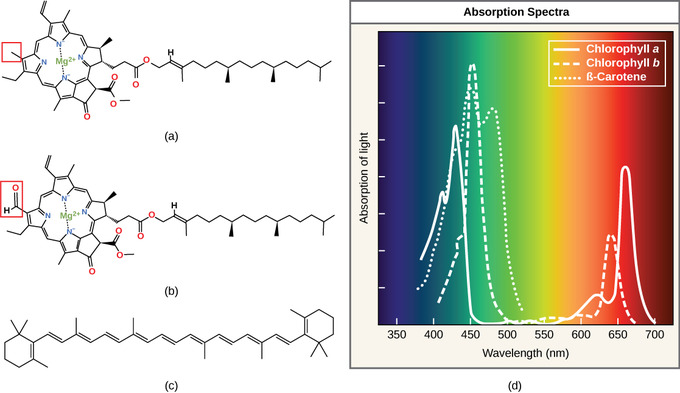Accessory pigments absorb energy that chlorophyll a does not absorb. Find out all about collagen including what it does the benefits to taking it and how much you might need.

Why Are Plants Green To Reduce The Noise In Photosynthesis Quanta Magazine

Photosynthesis Picture Id Ppt Download
1
Light with a wavelength of 460 nm is not significantly absorbed by chlorophyll a but will instead be captured by chlorophyll b.
What colour light does chlorophyll b absorb. 1 Its also thought to help protect against joint stiffness. Answer c trapping light energy. Weve already briefly discussed what vitamin C is and what it does but lets go into more detail.
2 But is it possible to harness the natural power of. Light in this range of wavelength is reflected. This green colour pigment plays a vital role in the process of photosynthesis by permitting plants to absorb energy from sunlight.
Of course you are familiar with the wavelength of the visible spectrum of light as well as the VIBGYOR. The discoloration is due to the breakdown of chlorophyll and other bio molecules back into their primary ingredients which are then pumped back into the rest of the plant for use elsewhere. Starch is a polysaccharide consisting of two kind of molecules.
Chlorophyll in a leaf is required for a breaking down water into hydrogen and oxygen b emitting green light c trapping light energy d storing starch in the leaves. BChlorophyll cWater dAll of these 5. Showing the ability of chlorophyll a pigment to absorb lights of different wavelengths Figure 133 a.
It is because leaf cells contain green pigments called Chlorophyll. This energy is used to synthesise prepare food from carbon dioxide and water. That is why leaves appear green.
1 IIIIII 2 II. It helps leaves to capture the ener gy of the sunlight. From Figure 133a can you determine the wavelength colour of light at which chlorophyll a shows the maximum absorption.
Why does leaf appear green. Accessory pigments include chlorophyll b also c d and e in algae and protistans xanthophylls and carotenoids such as beta-carotene. Chlorophyll is dissolved in ethanol III.
Chlorophyll the important light absorbing pigment in plants does not absorb light in the green part of the spectrum. Chlorophyll also chlorophyl is any of several related green pigments found in the mesosomes of cyanobacteria and in the chloroplasts of algae and plants. _____ colour of light is responsible for photosynthesis in bacteria.
In the Iodine test Iodine dissolved in aqueous solution of Potassium Iodide KI reacts. The main job our skin has is to protect our insides from any external dangers eg. Observe the colour of the pigments.
Absorption spectra showing how the different side chains in chlorophyll a and chlorophyll b result in slightly different absorptions of visible light. The function of vitamin C in the body include. Free PDF Download of CBSE Class 10 Science Chapter 6 Life Process Multiple Choice Questions with Answers.
Free MCQs of Class 10 Science Chapter 6 Life processes. Its been called the holy grail of skin health. So we find that chlorophyll sunlight carbon dioxide and.
The reason that light intensity does affect the rate of photosynthesis is because as light and therefore energy falls on the chloroplasts in a leaf it is trapped by the chlorophyll which then makes the energy available for chemical reactions in the plant. The plastids which impart green colour to leaves. Photosynthesis is the process by which living plant cells containing chlorophyll produce food substances glucose and starch from carbon dioxide and water by using light energy and release oxygen as a by-product.
During this time of year chlorophyll breaks down so the carotenoid pigments become visible. Does not turn blue black in colour whereas the other healthy leaf tests positive for starch turn blue black in colour. 4Light energy is converted into chemical energy during the process of _____.
Chlorophyll is the structural unit of photosynthesis. Pigments are also known to play a role in pollination where pigment accumulation or loss can lead to floral color change signaling to pollinators which flowers are rewarding and contain more pollen and nectar. At the end of Multiple Choice Questions the answer key has also been provided for your reference.
The lower layer is of yellow pigments these are also two. Only hydrophytes may absorb CO 2 from the water the terrestrial plants. Chlorophyll helps in trapping of sun light energy.
The photosynthesis happens at this site of leafs cell. The trapped insect gets entangled in the hair in-. Answer 1 of 12.
Answer b humidity. Chlorophyll is essential in photosynthesis allowing plants to absorb energy from light. The upper layer is of green pigments these are two chlorophyll A and chlorophyll B.
They absorb red and blue light and reflect green light which is what gives leaves their green colour. Chlorophyll and Photosynthesis When we see around us we find that most of the plant leaves are green in colour. In the experiment to show that light is necessary for photosynthesis some of the steps of the experiment deal with the following activities.
Chlorophyll is a mixture of chlorophyll-a and chlorophyll-bBesides green plants other organisms that perform photosynthesis contain various other forms of chlorophyll such as chlorophyll-c1 chlorophyll-c2. Starch reacts with iodine and gives blue-black colour II. 1- Anabolic 2-Red 3-a 4- False.
Which fraction of VIBGYOR is used during photosynthesis. Students can solve NCERT Class 10 Science Life Process Multiple Choice Questions with Answers to know their preparation level. Blue and Red fraction.
Amylose in starch is responsible for the formation of a deep blue color in the presence of iodine. What does vitamin C do in the body. This portion does not get light.
A Chloroplast b Xanthophyll c Leucoplast. Students can practice free MCQs as have been added by CBSE in the new Exam pattern. Closely packed flattened sacs arranged in piles in the interior of chloroplasts are called thylakoids.
The primary function of pigments in plants is photosynthesis which uses the green pigment chlorophyll and several colorful pigments that absorb as much light energy as possible. Since the synthesis of food occurs in the presence of sunlight it is called photosynthesisPhoto. MCQ Questions for Class 10 Science with Answers was Prepared Based on Latest Exam Pattern.
Life Processes MCQs Chapter 6 CBSE Class 10 Science Book Life processes Multiple Choice Questions MCQs with Answers. All photosynthetic organisms plants certain protistans prochlorobacteria and cyanobacteria have chlorophyll a. Its name is derived from the Greek words χλωρός khloros pale green and φύλλον phyllon leaf.
Whatever colour you want to call iton the buds. Carotenoids on the other hand reflect yellow orange and red the colour of leaves during autumn. Hot water makes leaf tissue soft The correct sequence of these steps is.
Plants that have more leaves that can absorb light will produce a greater yield. Which metal is present in both chlorophyll a and b.

8 2b Absorption Of Light Biology Libretexts

Chlorophyll A And B Spectral Absorption Graph Chlorophyll Light Therapy Photosynthesis

Chlorophyll A B And Carotenoids Absorbance Spectra Download Scientific Diagram
Do Plant Absorbs Blue Colour Light During Photosynthesis Quora

Biology Notes For A Level 101 Photosynthetic Pigments
The Light Dependent Reactions Of Photosynthesis Boundless Biology

Why Is Chlorophyll Green Quora
Chlorophyll Wikipedia

